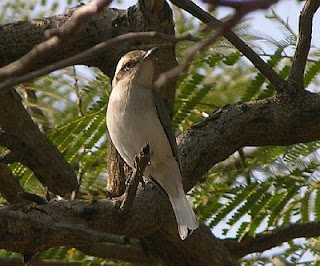There are nine species of Drongo and all of them come in wholly glistening black plumage except for two whose names are suggestive of the slight difference, that is, the white-bellied Drongo and the ashy-Drongo. In body size, they are all comparable to the Dove but with a much longer tail, ending in a deep, wide fork. The variety most particularly associated with Tiruvannamalai District is the Black Drongo. A dark red iris and a white beauty spot, the size of an aspirin tablet, between the eyes and the beak distinguish it from others of his species.
Photos of the Black Drongo






Drongo rolling for ants
*************************************************
Nesting Habits of the Black Drongo
The Black Drongo Dicrurus Macrocercus (Tamil=Karuvattu Vali) or Common King-Crow lays (throughout India) in April, August, but primarily in May, June and July.
The bird builds its nest in a fork of a tree, generally 10-30 feet from the ground. The nest of the King-Crow is usually composed of tiny twigs and fine grass-stems, and the roots of khus-khus grass, neatly and tightly woven together, and exteriorly bound round with a good deal of cobweb, in which a few feathers are sometimes entangled; the nest is generally a flimsy concern and the eggs are often visible from below. The cavity is broad and shallow, and at times lined with horsehair or fine grass, but most commonly only with khus. The bottom of the nest is very thin, but the sides or rim rather firm and thick; with cavity around 4 inches in diameter, and about 1½ in depth. This bird lays from between 3-5 eggs varying in size from 0·87 to 1·15 inch, and in breadth from 0·7 to 0·85. With the eggs varying greatly in colour, with some almost a pure white, and others spotted and blotched, especially at the larger end, with claret and light purple on a rich salmon-colored ground
 The nest with young
The nest with youngThe Drongo is very jealous of the approach of other birds (even of their own species) to a nest in which they have eggs. They are pugnacious to a degree, fearlessly attacking every bird that approaches the tree on which the nest may be. The birds are very noisy in the breeding-season, keeping all intruders off. The bird favours large trees preferably standing alone in the open. The Black Drongo puts Crows and Kites to flight should they venture to plunder bird nests of eggs and hatchlings. So peace-loving birds such as Doves and Mynahs prefer to build their nests directly below those of the Drongo.
 Young Drongo experiencing the world!
Young Drongo experiencing the world! Adult Drongo with juvenile
Adult Drongo with juvenile
The Black Drongo i.e. King-Crow, so conspicuous on the backs of cattle, telegraph-wires, all through the cold and hot seasons, is conspicuous by its absence during the breeding-season. Many of them retire to woods and gardens to breed, but even when they do not, they keep very quiet while they have their nests and hardly ever show themselves out of the tree.
Nice Video of a group of Black Drongos
**************************************************
I found a very interesting article by a bird lover on a mob Drongo Bird attack on a person. The article is amusing BUT shows just how aggressive and fearless this bird is!
"Drongos Attack!
You’re invited to join me for a morning jog… Just be prepared for a possible attack from above! Actually, possible attack from above, from below, from the right, from the left, and especially from the rear. It’s a bird; it’s a plane-- No! It’s the Black Drongo! The Black Drongo is a large, loud, black bird that has absolutely no fear of humans. To read more. Go to this link>>>






















































